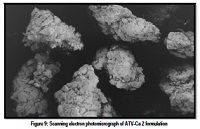Solubility and dissolution enhancement of poorly aqueous soluble drug atorvastatin calcium using modified gum karaya as carrier: In vitro-In vivo evaluation
Keywords:
Solid dispersion, solubility, dissolution, atorvastatin calcium, gum karaya, modified gum karaya, kneading, co-grinding, solvent evaporation, amorphous, crystallineAbstract
Solid dispersion is a unique and promising approach for improving the oral absorption and oral bioavailability of BCS class II drugs. Modified gum karaya a recently developed excipient was evaluated as a carrier for solubility and dissolution enhancement of poorly water soluble drug atorvastatin calcium. Physical mixtures along with solid dispersions of drug and polymer was prepared using three methods kneading, solvent evaporation and solvent wetting method in 5 different ratios (1:1,1:3,1:5,1:7,1:9). Among the three methods used atorvastatin calcium solid dispersions prepared by kneading method in 1:3 ratio showed most promising results in terms of percent yield, percent drug content, solubility of solid dispersions in phosphate buffer pH 6.8, XRD, DSC, SEM and In vitro release studies. These solid dispersions were selected to prepare tablets using Ac-di-sol as superdisintegrant (T1, T2, T3, T4 and T5). Tablets were characterized for hardness, friability, disintegration time, percent drug content, drug release studies and stability studies. Tablets T5 showed highest dissolution rate and best dissolution efficiency at (DE30) and (DE120) minutes. Release data of T5 tablet was subjected to various release kinetics models to know the type and order of drug release. Order was found to be Korsemeyer–Peppas>Hixson– Crowell cube root law >zero-order >first-order >Higuchi. The similarity factor was calculated for comparison of the dissolution profile before and after stability studies. The f2 value was found to be more than 50 (~ 90.9) thereby indicating a close similarity between both the dissolution profiles. In vivo studies was conducted on healthy albino rats and formulation given by oral route showed that at the end of 14 days solid dispersion 1:3 performed better than pure atorvastatin calcium in reducing total cholesterol and TG level and increasing HDL- cholesterol levels.
References
Vasconcelos T, Costa P. Development of a rapid dissolving ibuprofen solid dispersion. Pharm Res 2007; 16: 676-681.
Dhirendra K, Lewis S, Udupa N, Atin K. Solid dispersions: a review. Pak J Pharm Sci 2009; 22(2):234-246.
V G, Babu MM, Prasad DS, Murthy KVR. Evaluation of modified gum karaya as carrier for the dissolution enhancement of poorly water-soluble drug nimodipine, Int J Pharm 2002; 234: 1-17.
Kim JS, Kim MS, Park HJ, Jin SJ, Lee S, Hwang SJ. Physicochemical properties and oral bioavailability of amorphous atorvastatin hemi-calcium using spray drying and SAS process. Int J Pharm 2008; 359:211-219.
Patel M, Tekade A, Gattani S, Surana S. Solubility enhancement of lovastatin by modified locust bean gum using solid dispersion techniques. AAPS Pharm Sci Tech 2008; 9(4):1262.
V G, Babu MM, Prasad DS, Murthy KVR. Evaluation of modified gum karaya as carrier for the dissolution enhancement of poorly water-soluble drug nimodipine, Int J Pharm 2002; 234: 1-17.
Aulton EM, editor. Pharmaceutics: The science of dosage form design. 2nd ed. New York: Churchill Livingston; 2002.
Leon Lachman, The theory and practice of industrial pharmacy. 3rd ed. Bombay: Varghese Publishing House; 1991.
VG, Babu MM, Narayan P.S. Controlled release of diclofenac sodium by gum karaya chitosan complex coacervates: in vivo evaluation. Indian J Pharm Sci 2001; 63(5):408-412.
Modi A, Tayade P. Enhancement of dissolution profile by solid dispersion (kneading) technique. AAPS Pharm Sci Tech 2006; 7(3): E1-E6.
Karavas E, Ktistis G, Xenakis A, Georgarakis E. Effect of hydrogen bonding interactions on the release mechanism of felodipine from nanodispersions with polyvinylpyrrolidone. Eur J Pharm & Biopharm 2006; 63: 103-114.
Kim EJ, Chun MK, Jang JS, Lee IH, Lee KR, Choi HK. Preparation of a solid dispersion of felodipine using a solvent wetting method. Eur J Pharm & Biopharm 2006; 64:200–205
Shah TJ, Amin AF, Parikh JR, Parikh RH. Process optimization and characterization of poloxamer solid dispersions of a poorly water-soluble drug. AAPS Pharm Sci Tech 2007; 8(2): E1-E7.
Khan CA, Rhodes CT. The concept of dissolution efficiency. J Pharm Pharmcol 1975;27:48-49.
British Pharmacopoeia, The stationary office: London, 2003; Vol-1, 11.
Dehghan MHG, Jafar M. Improving dissolution of meloxicam using solid dispersions. Iranian J Pharm Res 2006; 4: 231-238.
Raval JA, Patel JK, Li N, Patel MM. Ranitidine hydrochloride floating matrix tablets based on low density powder: effects of formulation and processing parameters on drug release. Asian J Pharm Sci 2007; 2 (4): 130-142.
Patrick JS. Chemical kinetics and stability. In: Martin’s. Physical Pharmacy and pharmaceutical sciences.5th ed. Lippincott Williams and wilkins; 2006.p.402-432.
Ambike AA, Mahadik KR, Paradkar A. Spray-dried amorphous solid dispersions of simvastatin, a low Tg drug: in vitro and in vivo evaluations. Pharm Res 2005; 22:990-998.






